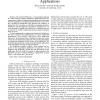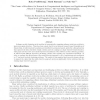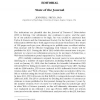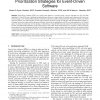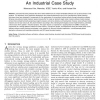135
click to vote
TSE
2011
14 years 8 months ago
2011
—Randomized testing is an effective method for testing software units. Thoroughness of randomized unit testing varies widely according to the settings of certain parameters, such...
148
click to vote
TSE
2011
14 years 8 months ago
2011
— We propose a new probabilistic temporal logic iLTL which captures properties of systems whose state can be represented by probability mass functions (pmf’s). Using iLTL, we c...
135
click to vote
TSE
2011
14 years 8 months ago
2011
— We present Bristlecone, a programming language for robust software systems. Bristlecone applications have two components: a high-level organization specification that describe...
101
Voted
TSE
2011
14 years 8 months ago
2011
Abstract— The Publish-Subscribe (P/S) communication paradigm fosters high decoupling among distributed components. This facilitates the design of dynamic applications, but also i...
TSE
2011
14 years 8 months ago
2011
Software module clustering is the problem of automatically organising software units into modules to improve program structure. There has been a great deal of recent interest in s...
117
click to vote
TSE
2011
14 years 8 months ago
2011
— We present an integrated method for program proving, testing, and debugging. Using the concept of metamorphic relations, we select necessary properties for target programs. For...
162
Voted
TSE
2011
14 years 8 months ago
2011
In this paper we present a case study in deriving an algorithm from a formal specification via FermaT transformations. The general method (which is presented in a separate paper)...
TSE
2011
14 years 8 months ago
2011
118
click to vote
TSE
2011
14 years 8 months ago
2011
—Event-Driven Software (EDS) can change state based on incoming events; common examples are GUI and web applications. These EDS pose a challenge to testing because there are a la...
123
click to vote
TSE
2011
14 years 8 months ago
2011
—Conventional testing methods often fail to detect hidden flaws in complex embedded software such as device drivers or file systems. This deficiency incurs significant developmen...

